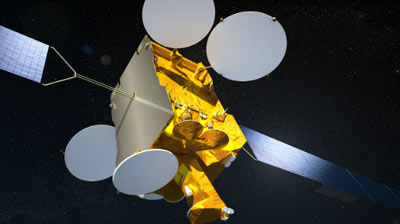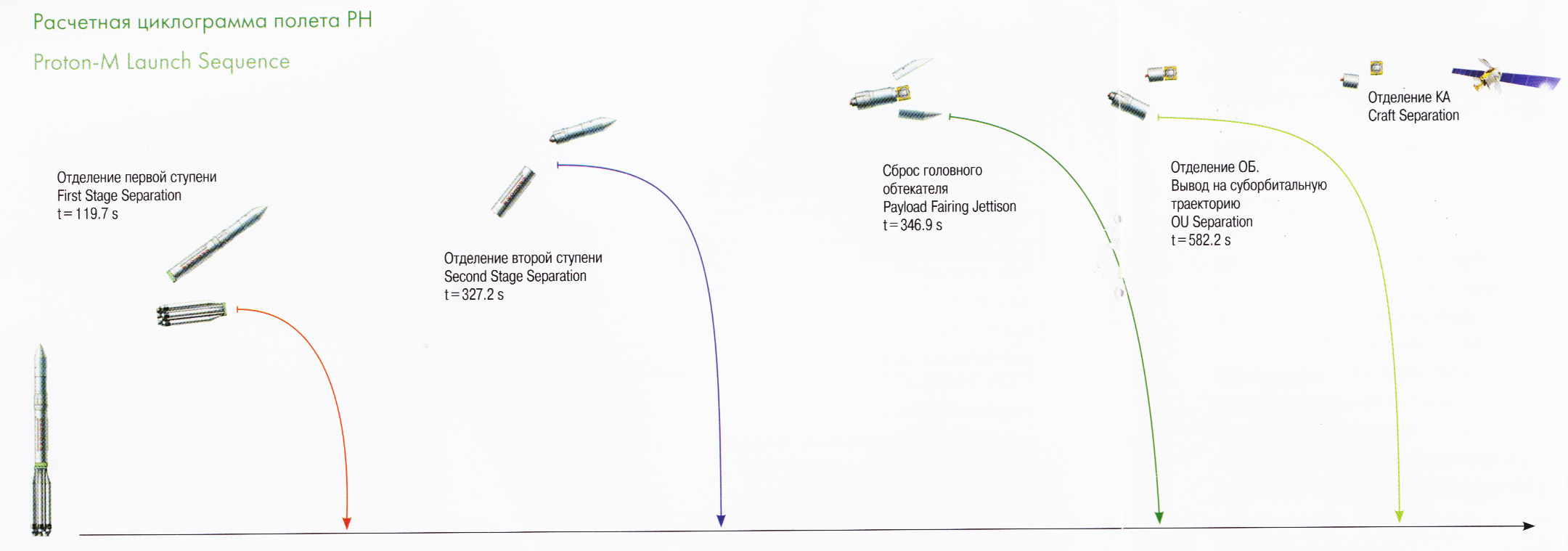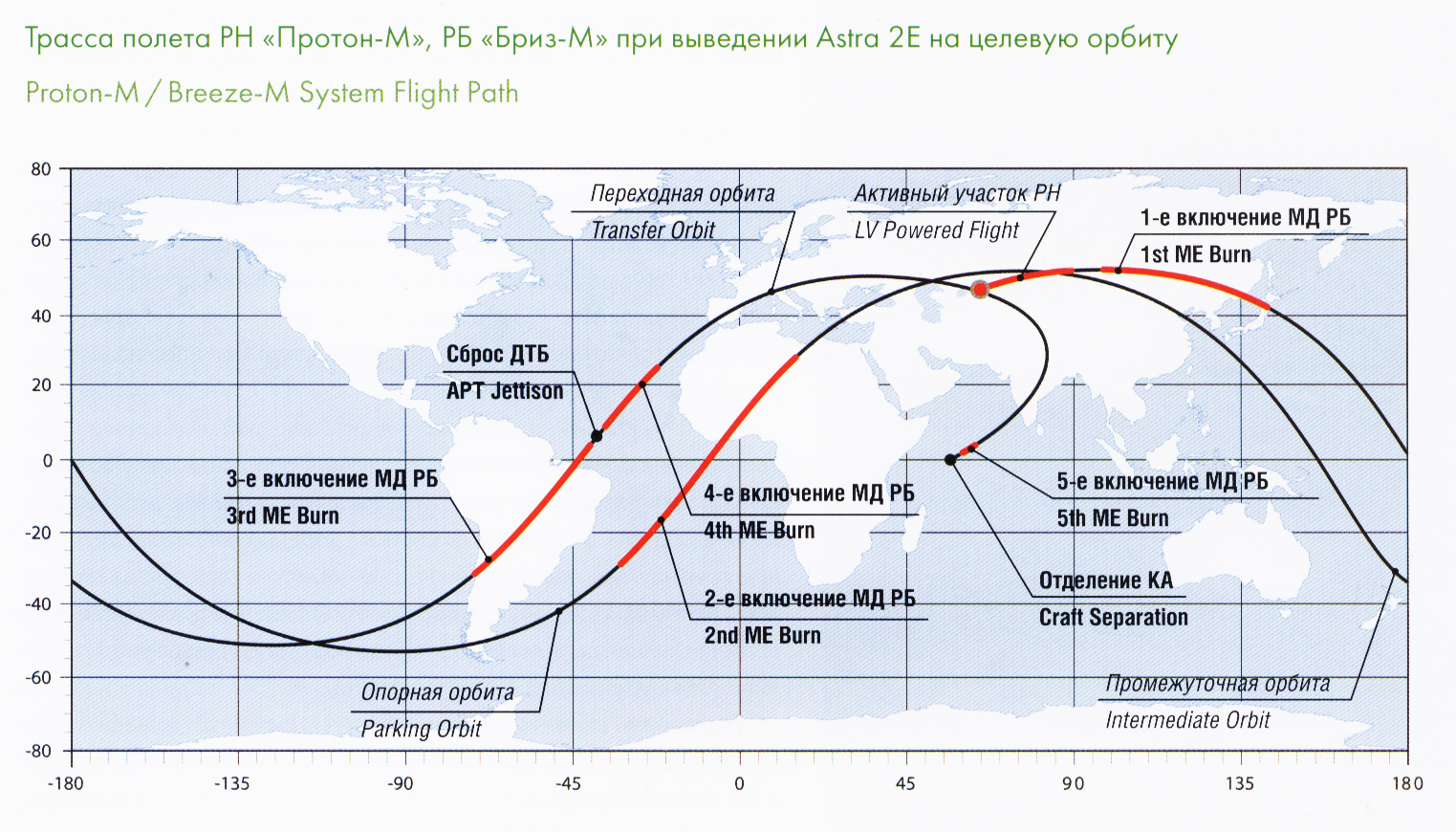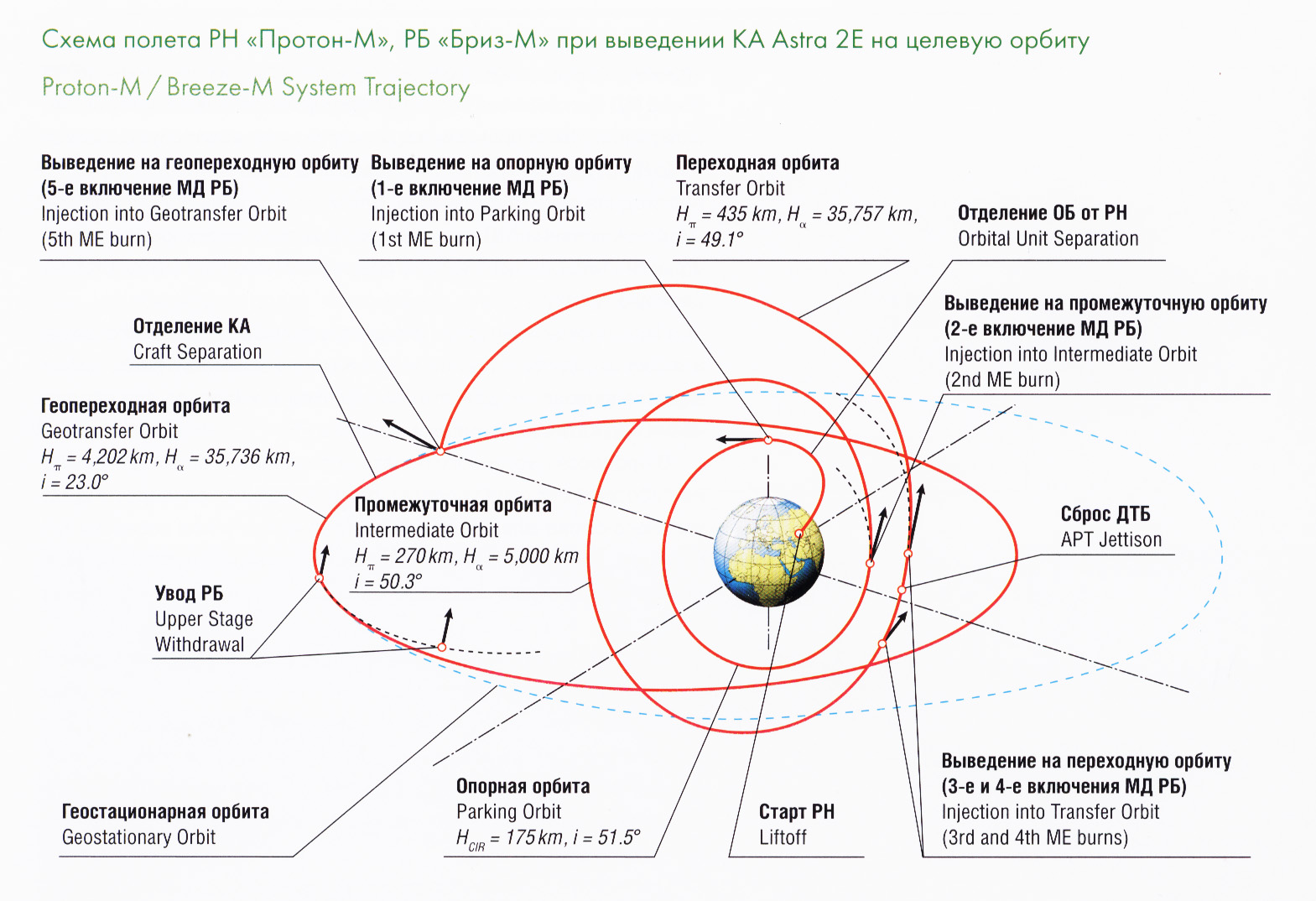Three months ago, a team of engineers from Astrium, one of the largest aerospace companies, were in Baikonur preparing the newest satellite for SES, one of the European telecommunication giants, for launch on July 20. One morning 2.5 weeks before the scheduled launch date, they took a break and go out to watch one of the same rockets they were to use lifting off. They expected to see it go almost straight upwards and disappear.
Instead they saw this:
Well I don't know if they still have nightmares on the 9.5 hours journey to orbit, but after investigations, modifications and another 2 weeks delay from September 16 to repair a fault in the rocket's first stage (which pushed their launch off from the new Falcon 9/Cygnus maiden flight, only to find that the Falcon is not going and the Cygnus is still wandering till tomorrow!), the satellite's finally slated to go to space tomorrow night, 8 hours after the Cygnus is scheduled to berth with the ISS and 5.5 hours after the Falcon 9 is scheduled to fly! With this being the 5th Proton RTF since December 2010, I am no longer sure that it has any symbolic meaning anymore, but.....here's the report for the launch!
This is the 5th commercial mission of the year for ILS and the 82nd ILS Proton mission since the first commercial flight of the Proton in April 1996.
This is the 23rd SES satellite launched with Proton and the 17th Astrium-built satellite launched on Proton.





Launch location:
Baikonur Launch pad no. 200/39 46° 2'23.85"N, 63° 1'54.98"E

Launch dates and times:
{colsp=6}Launch times
Time Zone |
{colsp=6}
Live Coverage Of The Launch:
PAYLOAD
Astra-2E communication satellite:

Mission Summary
SES S.A. and Astrium announced in December 2009 that SES has ordered four multi-mission satellites from Astrium to provide replacement as well as incremental capacity for its SES ASTRA and SES WORLD SKIES divisions.
The new satellites, to be designated Astra 2E, Astra 2F, Astra 2G and Astra 5B, will allow the release of the existing satellites at two orbital positions (28.2 and 31.5 degrees East) and add new capacity as well as fleet deployment flexibility for the SES group over the coming years. The satellites are scheduled for launch in several steps between 2012 and 2014. The design life of each satellite is 15 years.
The four new satellites will be built on a Eurostar-3000 platform.
Three of the new spacecraft, Astra 2E, Astra 2F and Astra 2G, will serve to deliver next generation broadcast, VSAT and broadband services in Europe and Africa, and will carry Ku-and Ka-band payloads at 28.2 degrees East.
The Ku-band capacity will allow SES ASTRA to enhance and secure its existing offering to major Direct-to-Home (DTH) markets in the UK and Ireland. With a Ku-band payload specifically designed to meet the requirements of some of Europe’s largest DTH broadcasters, the satellites will have spot beam and pan-European beam switching capabilities to accommodate both pay-TV and free-to-air broadcasters, and to provide these customers with increased functionality. The Ka-band payload will allow SES ASTRA to develop next generation broadband services in Europe, including its ASTRA2Connect product.
Astra 2E, Astra 2F and Astra 2G will also include replacement and new capacity for the SES WORLD SKIES division, serving the African and the Middle Eastern markets with Ku-and Ka-band capacity. The new capacity will provide continuity of service and expansion opportunities for customers that are today already using the Astra 2B steerable beam over West Africa, as well as for new customers
Astra 5B will be deployed at the orbital position 31.5 degrees East, extending SES ASTRA’s transponder capacity and geographical reach over Eastern European and neighboring markets for DTH, Direct-to-Cable (DTC) and contribution feeds to Digital Terrestrial Television (DTT) networks.
{colsp=2}Summary
Parameter | Value
Characteristics|
|

Launch Vehicle:
{colsp=2}Characteristics
 |
|
{colsp=2}

The vehicle's reliability statistics according to http://www.spacelaunchreport.com/log2013.html#rate:
Astra-2E Ascent Profile
The Proton-M first three stages place the orbital unit (OU), which consists of a Breeze-M upper stage, adapter system and Astra-2E, into a 51.5° inclination suborbital trajectory.
Proton-M powered flight lasts 582 seconds. The OU powered flight begins at the moment of the third stage separation.

Immediately after the separation of the third stage booster, the Breeze-M stability engines start, damping the angular velocities of the third stage separation and then providing orbital unit orientation and stability during coast flight along a suborbital trajectory to await the first burn. The upper stage follows a five-burn injection profile.



Astra-2E Ascent Timeline
Event|Time rel lift-off|Time UTC|Comment
Ignition Start Sequence|-00:00:02.5|21:38:07.5|
Stage 1 Ignition (40% thrust)|-00:00:01.75|21:38:08.25|
Command Stage 1 (100% thrust)|-00:00:00.9|21:38:09.1|
Maximum Dynamic Pressure|00:01:02|21:39:12|
1st/2nd Stage Separation|00:02:00|21:40:10|
2nd/3rd Stage Separation|00:05:27|21:43:37|
Payload Fairing Separation|00:05:47|21:43:57|
3rd Stage/Breeze M Separation|00:09:42|21:47:52|
1st Burn Ignition|00:11:16|21:49:26|
1st Burn Shutdown|00:15:47|21:53:57|1st Burn's Duration 00:04:31
2nd Burn Ignition|01:07:33|22:45:43|
2nd Burn Shutdown|01:25:17|23:03:27|2nd Burn's Duration 00:17:44
3rd Burn Ignition|03:28:12|01:06:22|
3rd Burn Shutdown|03:39:42|01:17:52|3rd Burn's Duration 00:11:30
APT Jettison|03:40:32|01:18:42|
4th Burn Ignition|03:41:59|01:20:09|
4th Burn Shutdown|03:47:52|01:26:02|4th Burn's Duration 00:05:53
5th Burn Ignition|08:53:08|06:31:18|
5th Burn Shutdown|08:59:24|06:34:52|5th Burn's Duration 00:03:34
Spacecraft Separation|09:12:00|06:50:10|
Weather forecast for Baikonur, Kazakhstan on September 30, 2013 (3 a.m.)
Clear. Low of 10C. Winds less than 5 km/h.
Time|Temps|Dew Point|Relative Humidity|Precip|Snow|Cloud cover|Pressure|Wind|Weather
2 AM|14°C|-3°C|29%|0%|0%|0%|1009 hPa|5 km/h WSW|
 Clear
Clear
References
http://www.federalspace.ru
http://tvroscosmos.ru
http://www.khrunichev.ru
http://www.ilslaunch.com
http://tihiy.fromru.com/Rn/RN_Proton.htm
http://space.skyrocket.de/doc_sdat/astra-2e.htm
http://www.ses.com
http://www.tsenki.com
http://forum.nasaspaceflight.com
http://www.novosti-kosmonavtiki.ru
http://www.spacelaunchreport.com
http://english.wunderground.com/cgi-bin/findweather/getForecast?query=44.84999847,65.50000000
Instead they saw this:
Well I don't know if they still have nightmares on the 9.5 hours journey to orbit, but after investigations, modifications and another 2 weeks delay from September 16 to repair a fault in the rocket's first stage (which pushed their launch off from the new Falcon 9/Cygnus maiden flight, only to find that the Falcon is not going and the Cygnus is still wandering till tomorrow!), the satellite's finally slated to go to space tomorrow night, 8 hours after the Cygnus is scheduled to berth with the ISS and 5.5 hours after the Falcon 9 is scheduled to fly! With this being the 5th Proton RTF since December 2010, I am no longer sure that it has any symbolic meaning anymore, but.....here's the report for the launch!
This is the 5th commercial mission of the year for ILS and the 82nd ILS Proton mission since the first commercial flight of the Proton in April 1996.
This is the 23rd SES satellite launched with Proton and the 17th Astrium-built satellite launched on Proton.





Launch location:
Baikonur Launch pad no. 200/39 46° 2'23.85"N, 63° 1'54.98"E

Launch dates and times:
Time Zone |
Baikonur / UTC+6
|
Moscow / UTC+4
|
Universal / UTC
|
Washington / EDT
|
Los Angeles / PDT
Launch time (Primary):
|
03:38:10
|
01:38:10
|
21:38:10
|
17:38:10
|
14:38:10
on:
|
Sep. 30, 2013
|
Sep. 30, 2013
|
Sep. 29, 2013
|
Sep. 29, 2013
|
Sep. 29, 2013
{colsp=6}
[highlight][eventTimer]2013-09-29 21:38:10?before|after;%dd% Days %hh% Hours %mm% Minutes %ss% Seconds %c%[/eventTimer] Astra-2E Launch[/highlight]
Live Coverage Of The Launch:
- International Launch Services: http://astra2e.imgondemand.com/ (begins at 20 minutes before lift-off)
- TSENKI Video Streams: http://www.tv-tsenki.com/livechoose.php
- Khrunichev COOPI (login: ? password: ?): http://coopi.khrunichev.ru/main.php?id=200
- Owners of PDA can watch the launch in test mode on: http://www.space-center.ru
PAYLOAD
Astra-2E communication satellite:

Mission Summary
SES S.A. and Astrium announced in December 2009 that SES has ordered four multi-mission satellites from Astrium to provide replacement as well as incremental capacity for its SES ASTRA and SES WORLD SKIES divisions.
The new satellites, to be designated Astra 2E, Astra 2F, Astra 2G and Astra 5B, will allow the release of the existing satellites at two orbital positions (28.2 and 31.5 degrees East) and add new capacity as well as fleet deployment flexibility for the SES group over the coming years. The satellites are scheduled for launch in several steps between 2012 and 2014. The design life of each satellite is 15 years.
The four new satellites will be built on a Eurostar-3000 platform.
Three of the new spacecraft, Astra 2E, Astra 2F and Astra 2G, will serve to deliver next generation broadcast, VSAT and broadband services in Europe and Africa, and will carry Ku-and Ka-band payloads at 28.2 degrees East.
The Ku-band capacity will allow SES ASTRA to enhance and secure its existing offering to major Direct-to-Home (DTH) markets in the UK and Ireland. With a Ku-band payload specifically designed to meet the requirements of some of Europe’s largest DTH broadcasters, the satellites will have spot beam and pan-European beam switching capabilities to accommodate both pay-TV and free-to-air broadcasters, and to provide these customers with increased functionality. The Ka-band payload will allow SES ASTRA to develop next generation broadband services in Europe, including its ASTRA2Connect product.
Astra 2E, Astra 2F and Astra 2G will also include replacement and new capacity for the SES WORLD SKIES division, serving the African and the Middle Eastern markets with Ku-and Ka-band capacity. The new capacity will provide continuity of service and expansion opportunities for customers that are today already using the Astra 2B steerable beam over West Africa, as well as for new customers
Astra 5B will be deployed at the orbital position 31.5 degrees East, extending SES ASTRA’s transponder capacity and geographical reach over Eastern European and neighboring markets for DTH, Direct-to-Cable (DTC) and contribution feeds to Digital Terrestrial Television (DTT) networks.
Parameter | Value
Working Orbit:
|
GEO
Orbital Location:
|
28.2° East
Coverage:
|
Europe, Middle East
ApA at separation:
|
35736 km
PeA at separation:
|
4202 km
Inc at separation:
|
23.0°SES-6
Customer:
|- SES S.A.
Prime contractor:
|- EADS Astrium
Platform:
|- Eurostar E3000
Mass at Separation:
|- 6052 kg
Dry Mass:
|- ?
Stabilization:
|- 3 axis stabilized
Dimensions (stowed):
|- ?
Batteries:
|- ?
Payload:
|- 60 Ku-band transponders
- 3 Ka-band transponders
Life time:
|- 15 years
Coverage:
|-
| -
| -
| -
|

Launch Vehicle:

Proton-M / Briz-M
Prime contractor:
|- Khrunichev Space Centre

GRAU Index:
|- 8K82KM
Height:
| 58.2 m with upper stage and payload fairingDiameter:
| max 7.4 mLiftoff mass:
| 705 metric tonnesPayload mass:
| ~22 tonnes at LEO1st stage:
|- 6 X RD-275 engines
- Empty 30.6 tonnes
- Propellants 419.41 tonnes (UDMH and NTO)
- Thrust in vacuum 1069.8 tonnes of force
- Thrust at sea level 971.4 tonnes of force
2nd stage:
|- 1 X RD-0211 engine 3 X RD-0210 engines
- Empty 11.4 tonnes
- Propellants 156.113 tonnes (UDMH and NTO)
- Thrust in vacuum 237.4 tonnes of force
3rd stage:
|- 1 X RD-0213 engine & 1 X RD-0214 vernier engine
- Empty 3.7 tonnes
- Propellants 46.562 tonnes (UDMH and NTO)
- Thrust in vacuum 59.36 (core) + 3.15 (vernier) tonnes of force
Upper Stage:
|

- GRAU Index: 14S43
- Common Name: Briz-M
- Designer & Manufacturer: Khrunichev Space Centre
- Dimensions: Length 2.654 m, Diameter 4 m
- Empty Mass 2.2 tonnes
- Propellants 6 660 kg UDMH + 13 260 kg N2O4
- Flight time: no less than 24 hours
- Main Engine: 1 X 14D30
- Thrust in vacuum 2.0 tonnes of force
- ISP 328.6 s
- Main engine restarts: up to 8 times
- Precision Manoeuvering Engines: 4 X 11D458
- Thrust in vacuum 400 N each
- ISP 252 s
- RCS Engines: 12 X 17D58E
- Thrust in vacuum 13.3 N each
- ISP 274 s
Payload Fairing:
|- Diameter 4.35 m
- Length 11.6 m
The vehicle's reliability statistics according to http://www.spacelaunchreport.com/log2013.html#rate:
Code:
================================================================
Vehicle Successes/Tries Realzd Pred Consc. Last Dates
Rate Rate* Succes Fail
================================================================
Proton-M/Briz-M 60 66 .91 .90 4 12/08/12 2001-Astra-2E Ascent Profile
The Proton-M first three stages place the orbital unit (OU), which consists of a Breeze-M upper stage, adapter system and Astra-2E, into a 51.5° inclination suborbital trajectory.
Proton-M powered flight lasts 582 seconds. The OU powered flight begins at the moment of the third stage separation.

Immediately after the separation of the third stage booster, the Breeze-M stability engines start, damping the angular velocities of the third stage separation and then providing orbital unit orientation and stability during coast flight along a suborbital trajectory to await the first burn. The upper stage follows a five-burn injection profile.



Astra-2E Ascent Timeline
Ignition Start Sequence|-00:00:02.5|21:38:07.5|
Stage 1 Ignition (40% thrust)|-00:00:01.75|21:38:08.25|
Command Stage 1 (100% thrust)|-00:00:00.9|21:38:09.1|
Maximum Dynamic Pressure|00:01:02|21:39:12|
1st/2nd Stage Separation|00:02:00|21:40:10|
2nd/3rd Stage Separation|00:05:27|21:43:37|
Payload Fairing Separation|00:05:47|21:43:57|
3rd Stage/Breeze M Separation|00:09:42|21:47:52|
1st Burn Ignition|00:11:16|21:49:26|
1st Burn Shutdown|00:15:47|21:53:57|1st Burn's Duration 00:04:31
2nd Burn Ignition|01:07:33|22:45:43|
2nd Burn Shutdown|01:25:17|23:03:27|2nd Burn's Duration 00:17:44
3rd Burn Ignition|03:28:12|01:06:22|
3rd Burn Shutdown|03:39:42|01:17:52|3rd Burn's Duration 00:11:30
APT Jettison|03:40:32|01:18:42|
4th Burn Ignition|03:41:59|01:20:09|
4th Burn Shutdown|03:47:52|01:26:02|4th Burn's Duration 00:05:53
5th Burn Ignition|08:53:08|06:31:18|
5th Burn Shutdown|08:59:24|06:34:52|5th Burn's Duration 00:03:34
Spacecraft Separation|09:12:00|06:50:10|
Weather forecast for Baikonur, Kazakhstan on September 30, 2013 (3 a.m.)
Clear. Low of 10C. Winds less than 5 km/h.
2 AM|14°C|-3°C|29%|0%|0%|0%|1009 hPa|5 km/h WSW|
References
http://www.federalspace.ru
http://tvroscosmos.ru
http://www.khrunichev.ru
http://www.ilslaunch.com
http://tihiy.fromru.com/Rn/RN_Proton.htm
http://space.skyrocket.de/doc_sdat/astra-2e.htm
http://www.ses.com
http://www.tsenki.com
http://forum.nasaspaceflight.com
http://www.novosti-kosmonavtiki.ru
http://www.spacelaunchreport.com
http://english.wunderground.com/cgi-bin/findweather/getForecast?query=44.84999847,65.50000000























